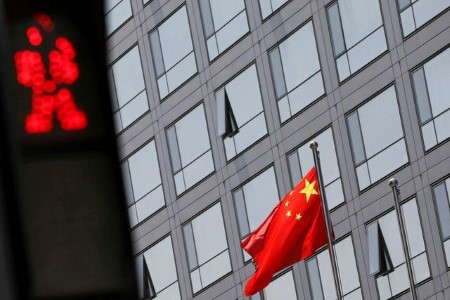




Monthly Economic Update: One for the road
 DOWNLOAD
DOWNLOAD

Inflation Update: Still low, still slow
 DOWNLOAD
DOWNLOAD

Philippines Trade Update: Exports momentum continues
 DOWNLOAD
DOWNLOAD


China turns the heat up on cross-border investments in local govt debt, sources say

HONG KONG, April 23 – Chinese regulators are inspecting the use of a cross-border mechanism to invest in debt-laden local governments’ offshore bonds, two sources said, indicating a ramping up of efforts to contain financial risks in a loosely regulated part of the market.
The move comes after offshore debt issuances by the local governments, who already owe more than USD 9 trillion, surged in recent months and touched the highest monthly volume in more than a year in January.
The rush of new offshore bond offerings by the indebted local governments comes at a time when regulations for onshore issuances have been tightened and many of them are struggling to meet existing liabilities, with a slowing economy and a property sector crisis weighing on their financial health.
The China Securities Regulatory Commission (CSRC) last month queried asset managers holding Qualified Domestic Limited Partnership (QDLP) licenses on their exposure to offshore debt of local government financing vehicles (LGFVs), which borrow on behalf of the governments, said the two sources.
First launched in 2012, the loosely regulated and quota-based QDLP channel allows foreign and domestic fund managers to raise money from Chinese high-net-worth individuals and institutions, which is then invested in offshore products.
The increased scrutiny of QDLP stems from a suspicion that the mechanism’s use for local government offshore debt investing undercuts Beijing’s efforts to resolve provincial debt risks, with investors being lured by the weak domestic market returns and higher yield offered by the offshore bonds.
It was not clear if other cross-border investment mechanisms too face similar checks.
Apart from the query, a team of officials from the CSRC and the State Administration of Foreign Exchange (SAFE) held a closed-door meeting with QDLP fund managers in China’s southern Hainan province late last month, the sources said.
Around 10 domestic and foreign asset managers, who have QDLP licenses, attended the meeting. Local governments in China have the authority to grant QDLP licenses, and Hainan has been one of the most active issuers of such approvals.
At the meeting, which has not been reported previously and was held to review the practices of the QDLP business over the past decade, the regulators asked the managers how the cross-border investment quotas were used, said the sources, who declined to be named due to the sensitivity of the matter.
It was not immediately clear if and when the regulators would take any action against the managers.
CSRC and SAFE did not reply to Reuters requests for comment on Tuesday.
‘TOUGHER MEASURES’
Currently, the process of obtaining QDLP licenses and raising QDLP funds is handled by around 10 local governments, rather than the central government regulator, making it one of the most flexible cross-border investment channels.
Some Chinese investors in the recent past have been offering high fees – in one case as high as 5% of the investment sum – to QDLP license holders to get access to LGFV offshore bond quotas, one of the two sources and a third source said.
LGFVs are used to borrow on behalf of Chinese provinces and cities to finance mainly infrastructure projects. In recent times, a chunk of their borrowings have gone towards refinancing debt.
The total local governments’ dollar bonds issuance hit USD 2.2 billion in January, the highest monthly volume since Nov. 2022, according to data provider Dealing Matrix.
Roughly 40% of the 28 such bonds issued in January offered more than 7%, compared with average returns of 3% on their onshore debt, its data show.
“With issuance by Chinese property developers shrinking over the past few years, LGFVs contributed a bigger portion – around half of the corporate bond issuance in 2023,” said Jessie Tung, senior credit officer at Moody’s, who expected LGFVs to remain a major bond issuance sector in future.
But the more than USD 9 trillion worth of local government debt poses a major risk to the Chinese economy and the country’s financial stability, economists say, amid a deepening property crisis and years of over-investment in infrastructure.
Beijing has rolled out several measures over the last few months to reduce local government debt risks, including instructing some of the heavily indebted municipalities to delay or halt some state-funded infrastructure projects.
Earlier this year, regulators told LGFVs to stop issuing offshore bonds with a 364-day duration.
Although the offshore market only makes up a small fraction, under 5% of total LGFV debt, Moody’s Tung expected “regulators to tighten criteria for LGFVs’ bond issuance offshore”.
LGFVs face a maturity wall of USD 35 billion this year, compared to USD 24 billion in 2023 and USD 33 billion in 2022, according Moody’s data.
Even as Beijing is tightening issuance of new LGFV offshore bonds, the existing debt in the market will trigger “a distressed situation and a mess,” said a QDLP license holder, who did not want to be identified as the matter was sensitive.
(Reporting by Xie Yu; Additional reporting by Selena Li, Samuel Shen, Clare Jim, and Li Gu; Editing by Sumeet Chatterjee and Muralikumar Anantharaman)
This article originally appeared on reuters.com





 By Reuters
By Reuters